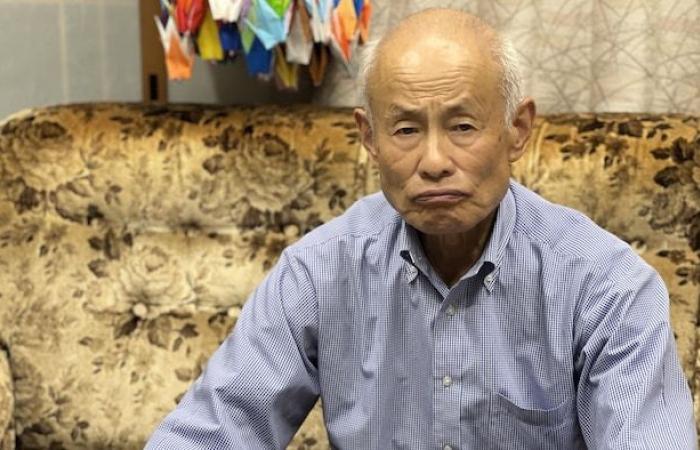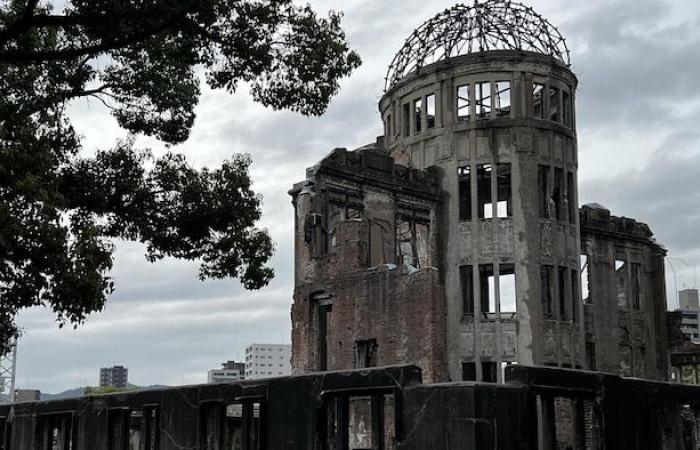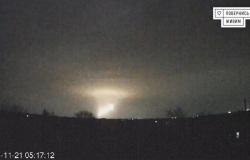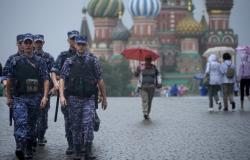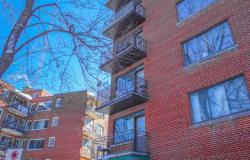In the modest home of 81-year-old survivor Toshiyuki Mimaki located an hour’s drive from downtown Hiroshima, everything recalls the horror of the bomb.
A disturbing painting with orange accents entitled A child looking at falling debris in 1945 adorns one of the walls.
Another painting depicts the comfort offered by his own family in the moments following the horror of August 6, 1945, when the first atomic bomb in history was dropped.
That morning I was outside and saw a light in the sky. I thought it was lightning. I didn’t think it was anything serious. I was only three years old. In the afternoon, many people passed by our house. They were tired and injured. My mother gave the victims a can of peaches. Afterwards, she told me that it was an attack and that there was no longer a city of Hiroshima.
explains Toshiyuki Mimaki calmly.
Between 60,000 and 80,000 people died instantly when an American bomber dropped a nuclear bomb equivalent to the power of 15,000 tons of TNT on Hiroshima on the morning of August 6, 1945.
The death toll rose to between 103,000 and 220,000 after the plutonium bomb dropped on Nagasaki three days later.
Open in full screen mode
Toshiyuki Mimaki was in Hiroshima as a child the day the bomb struck.
Photo : - / Philippe Leblanc
When he watches the news, Mr. Mimaki is saddened to see what is happening in Gaza and Ukraine.
I’m quite pessimistic. I also feel like the world is becoming more and more violent. Additionally, heads of state like Vladimir Putin use nuclear missiles as a threat, as a political tool. This is not normal. We cannot forget the war and what we experienced
he said
In the moments after the Nihon Hidankyo survivors’ association was awarded the Nobel Peace Prize in October, Toshiyuki Mimaki compared the fate of bombed children in the Gaza Strip to what the Japanese experienced in 1945 .
Israel’s ambassador to Japan strongly condemned the comments of the head of the Hiroshima chapter of the survivors’ association.
At the gigantic Hiroshima Peace Memorial site, Hiroko Nishimura leads a group of tourists to the most important places, including the Genbaku Dome, the only building to remain standing near the site where the atomic bomb blew up the city.
Open in full screen mode
The Genbaku Dome, the only building to remain standing near the site where the atomic bomb blew up the city.
Photo : - / Philippe Leblanc
She has been a guide for the Nihon Hidankyo association for 24 years. She is the daughter of an irradiated survivor.
It was her young daughter, then intrigued by the names inscribed on the atomic bomb memorial, who pushed her to undertake this journey of memory.
When she asked me if her grandfather was among the names of the victims inscribed in the memorial, I realized the extent of my ignorance. My father, irradiated at 15, remained silent, as if he could not talk about that day. His silence has become a weight that I carry
she said.
Hiroko Nishimura believes that the nuclear threat and war affect everyone today and that memory is a collective responsibility.
Unfortunately, I have the impression that the world is not moving towards peace. Our only weapon is the voice of witnesses. We can take advantage of the fact that we won the Nobel Peace Prize to recruit and to transmit our message of peace to the world
she said

Open in full screen mode
Hiroko Nishimura is a guide for the Nihon Hidankyo association.
Photo : - / Philippe Leblanc
Mr. Mimaki does not know if he will be able to go to Oslo on December 10 for the official award of the Nobel Peace Prize to Nihon Hidankyo.
Since the age of ten, he has developed recurring health problems which he attributes to the after-effects of exposure to the atomic bomb.
He suffered from repeated fevers and today he has water in his lungs.
I was ashamed to talk about it. I didn’t tell anyone that it could be because of the atomic bomb. I didn’t talk about it for a long time
he said.
He still finds it hard to believe that the prize is going to Nihon Hidankyo after all these years.
The organization was created in 1956 to send a message of peace and to campaign against nuclear weapons in the wake of the tragedy of the Japanese boat Daigo Fukuryū Maru, irradiated during an American nuclear test of the H-bomb in 1954.

